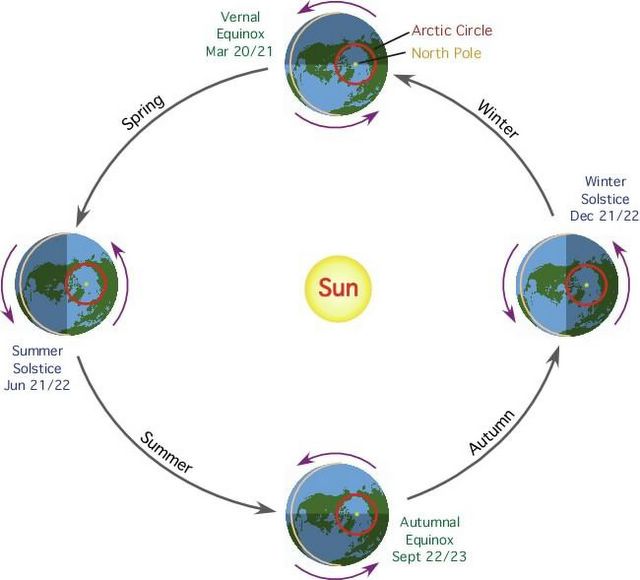Longer and Longer

(Created by Dr. Michael Pidwirny, University of British Columbia Okanagan, PhysicalGeography.net)
These days everything is getting longer. I'm working longer hours. I'm running longer distances. I'm experiencing longer bouts of leg pain. I'm even taking substantially longer periods of time getting out of bed. All this is minor detail, however, in light of the fact that the days are now getting longer. Tuesday marked the Vernal Equinox.....the first day of Spring. This day usually flies under most people's radar, specially those living in Michigan where warm temperatures and spring-like weather don't arrive until June. Not in my family.
You see, I grew up in a family where such things as the Winter Solstice and Spring Equinox rivaled Christmas and birthdays in importance. This was primarily due to my father's weird obsession with the Earth's rotation and how it affects the amount of daylight. Presumably, he once aced a grade school geography test on this very subject and was applauded by the flock of nuns presiding over his education. Forty years later, he still reminds the family of his extensive, yet often irrelevant, knowledge about the longest and shortest days of the year.
As my weekday mileage is getting longer, I can finally admit that the old man's teachings have reached a point of actual relevancy and usefulness. You may be asking yourself what exactly is the Vernal Equinox? My father is glad you asked! Basically, the Spring (or Vernal) Equinox is the point in the Earth's rotation when the days start to get longer. The sun continues to follow a higher and higher path through the sky until it reaches its highest point on the Summer Solstice. The annual change in the relative position of the Earth's axis in relationship to the sun causes the height of the sun to vary in our skies. The sun's height in the sky is also affected by the fact that the Earth is tilted on its axis either toward or away from the center of the sun. During the equinox, however, the axis of the Earth is not tilted toward or away from the sun and the circle of illumination cuts through the poles. I'm sure you can imagine why this bit of fatherly knowledge roused a less than an enthusiastic response from my brother and me. There's nothing like discussion about the tilt of the Earth's axis that brings out the passions in everyone!
The bottom line, every place on earth experienced exactly 12 hours of day light on Tuesday. The model above may be more helpful, if not more painfully dull. From now until June, each day brings a little more sunshine for me to use during training. This meant very little to me as a kid. During my training, however, this news is greeted with much more enthusiasm. One less minute of running in the eerie darkness of Detroit, is warmly welcomed. Fortunately for all you (insert extreme sarcasm), I can explain why this is occurring. I owe it all to the nuns who taught my old man geography. I'm looking forward to the longer days with the longer miles.

0 Comments:
Post a Comment
<< Home